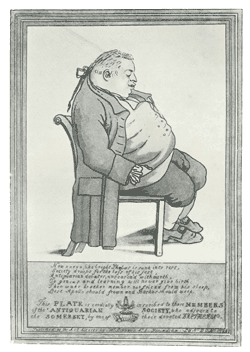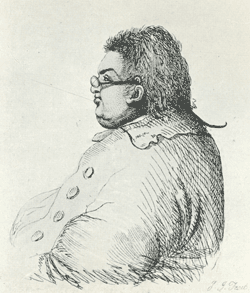Francis Grose, Topographical Draughtsman
(b. 1731, d. 1791)
Topographical Draughtsman
From A Dictionary of Irish Artists 1913

Francis Grose. Print in British Museum; published in 1785.
Was born at Greenford, Middlesex, in 1731, the eldest son of Francis Jacob Grose, or Grosse, a native of Berne in Switzerland, who was a jeweller at Richmond, Surrey. Having a taste for heraldry and antiquities he obtained a place in the College of Arms, which he resigned in 1763. He studied drawing in Shipley's school, and became a member of the Society of Artists, with whom he exhibited architectural views in 1767 and 1768. He was also an exhibitor in the Royal Academy from 1769 to 1777, contributing sixteen tinted drawings of architectural views, a "Snow Scene from Fancy," 1771, and "Strollers in the characters of Anthony and Cleopatra," 1774. He was adjutant and paymaster of the Hampshire militia, and afterwards of the Surrey militia. Left by his father with independent means he was able to indulge his taste for antiquarian pursuits, and was author of many works, several of them illustrated by himself. In 1773 he published the first number of his "Antiquities of England and Wales," a work completed and published in four volumes, folio, in 1787. In 1789 he made a tour in Scotland which resulted in his "Antiquities of Scotland," published in 1789-91, in two volumes. Among others of his works were "The Antiquarian Repertory," four volumes, 1775; "A Treatise on Ancient Armour and Weapons," 1786, and "Military Antiquities," three volumes, 1786-88. He supplied drawings done in 1760 for the Rev. W. Darrell's "History of Dover Castle," published in 1786, and etched the illustrations for the new edition of his brother John Henry Grose's "Voyage to the East Indies," 1766; he also drew and etched a "Portrait of Thomas Inglefield, born without arms and legs," which was published in 1787.
After the completion of his "Antiquities of Scotland" he began to prepare a similar work upon Ireland, and came over to Dublin in May, 1791. He had, however, apparently visited Ireland before, as two of his drawings, afterwards engraved for his "Antiquities of Ireland," were done in 1790, and three as early as 1770. On his arrival in Dublin he immediately commenced an antiquarian tour, accompanied by his assistant Thomas Cocking (q.v.), and made a few drawings for his projected book. The progress of the work was, however, suspended by his sudden death. On the evening of the 12th May, 1791, he arrived at the house of Horace Hone, the miniature painter, in Dorset Street, where he had been invited to dine—Camillus Hone, James Gandon, the architect, the two Miss Gandons and Christopher Pack, the painter, being of the company. Almost immediately upon entering the house he was seized with an apoplectic fit, which in a few moments ended his life. He was buried on the 18th May in Drumcondra churchyard, in the presence of his nephew, Lieutenant Daniel Grose, the two Hones, James Gandon, Pack and others. A View of the church and churchyard, drawn by Daniel Grose and engraved by Sparrow, was published by S. Hooper in 1791, and also appears in the second volume of the "Antiquities of Ireland." The print bears the following inscription: To James Gandon and Samuel Walker, Esqrs., Mr. Horace Hone and Richd. Edwd. Mercier, who attended the funeral of the late Francis Grose, Esqr., to the Church of Drumcondra, near Dublin, where his Remains were deposited 18th May, 1791. This View is inscribed by their Humble Servant Samuel Hooper. N.B.—The figure of Capt. Grose in this print is placed on his own grave." Grose was short in stature and immensely corpulent; Christopher Pack describes him as "five feet high and weighing twenty-two stone, with a coat cut in the fashion of thirty summers back, with large boots hanging over his ankles" (see Pasquin, p. 47.) A Dublin butcher soliciting his custom exclaimed, "Only say you buy your meat of me and you'll make my fortune!" He was a great eater and drinker and fond of sleep; he is represented asleep in his chair in a portrait published in 1785. Of a simple and honest nature, his Falstaffian wit and his good humour afforded as much enjoyment to himself as to his friends.

Francis Grose. Print in British Museum.
At the time of his death only twenty-four views had been engraved for the "Antiquities of Ireland," and but seven pages of the text written. The "St. James's Evening Post" suggested for his epitaph "Death put an end to his Views and Prospects." The work was taken up by his nephew, Lieutenant Daniel Grose (q.v.), and by the Rev. Edward Ledwich who contributed the descriptive letterpress. In addition to the drawings already made, mostly by Cocking and some by Daniel Grose, William Burton-Conyngham contributed from his collection drawings by Bigari, J. J. Barralet and others. The work was published by Samuel Hooper, of Holborn; Volume I in 1794, although the title-page bears the date 1791, and Volume II in 1796. Only the following plates after Grose's own drawings appeared; "Baldungan Castle and Church," "Howth Church," "Lusk Church," "Church and Tower at Dundalk," "Roche Castle," "St. Mary's, Drogheda," "Augher Castle," two views of "Blaney Castle," and "Dundrum Castle." This latter plate does not bear his name, but his original drawing is in the possession of Mr. W. G. Strickland. The other plates in the work are after drawings by Thomas Cocking, J. J. Barralet, A. M. Bigari, Daniel Grose, J. G. Brien, Rev. Dr. Wynne, William Beauford, J. Gandon, junr., P. S. Reiley, — Nixon, — Murphy, A. Chearnley, F. Wheatley, W. Ashford, Jonathan Fisher, and Henry Pelham.
Grose married a Miss Catherine Jordan of Canterbury, and had two sons and five daughters. The eldest son, Captain, afterwards Lieut.-Gen. Francis Grose, was acting Governor of New South Wales, 1792-1794, and died in 1814. Several portraits of Francis Grose, were done: 1st, etching by Bartolozzi, after N. Hone, frontispiece to the "Antiquities of England"; 2nd, copy of foregoing, by W. Ridley, in "European Magazine," 1797; 3rd, another copy, anonymous, 1796; 4th, with Theodosius Forrest, represented as two friars in N. Hone's picture and mezzotint of "Monachum non facit Cucullus"; 5th, a half-length in profile; vignette by S. Ireland; 6th, woodcut by Lee, in Pierce Egan's "Sporting Anecdotes," 1825; 7th, water-colour sketch in British Museum, representing him asleep in a chair; published in etching and aquatint by Fores in 1785.
« Daniel Charles Grose | Contents and Search | John Gubbins »
